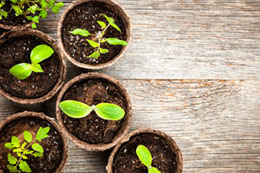If you are fond of fresh pumpkins but are short on space, cursed with bad soil, or too much frost, then growing pumpkins in containers is an ideal option.

Pumpkin belongs to the genus
Cucurbita and the family
Cucurbitaceae. The other members of this family are squashes and gourds. Pumpkins are powerhouses of minerals and vitamins . They are mostly yellow or orange, dark and light both, round, oblong, or oval in shape with deep creases running from the stem to the bottom of their thick skin. On cutting it open, one can find seeds and white flesh in it. In this article, you will learn the art of growing pumpkins in containers.
Vital Information
There are many reasons why people prefer container gardening over other forms of gardening. For those who are restricted on space, growing seasonal flowers and vegetables in small pots will ensure that they have a regular supply of their choice of vegetables and flowers. Another reason maybe the presence of bad soil. One of the primary advantages of this kind of planting is the control one can have over the quality of soil and its pH balance. To save the trailer from harsh climate is also another reason. Besides these choices, some people do it as a form of hobby, while others prefer to have neat looking gardens. Whatever may be the reason, at the end of it, with a little bit of care, you will have a healthy pumpkin in your hands.
Seeds
Growing pumpkins from seeds is quite easy. Decide upon the type of the vegetable you want. Seeds should be sowed in early September or mid-spring, whichever is earlier. Buy seeds from a reputable vendor. In a smaller pot, add free draining potting soil. Pre-soak the seeds an hour before sowing them. The moisture set in them will hasten their process of germination. Sow seeds individually on its side and create a mound over it. Keep this in a shaded area. For small pots, stand them in water until the top soil gets drenched, whereas for large pots, spray mist. Water frequently until they sprout, which should be ideally in around a week. While sowing seeds in large pots, if you maintain one foot difference between two seeds, you do not need to transplant them. Otherwise, your seedlings are ready for transplantation when they reach a four leaf stage.
Taking Care
Spacing and planting these vegetables in pots will depend upon the variety. It would be best to keep quite a bit of distance between them, as the plants are vines, so they grow tall and spread. Too many of them in the same pot will just end up entangling each other resulting in poor yield. Pumpkins prefer a rich, loamy , enhanced soil, which will require a bit of composting. The soil should be well drained and be able to retain moisture at all times. Take a pot that is at least two to three feet deep and two feet in diameter. Fill it up with nutrient rich potting soil. Plant the seedling and water it well. Move it to a sunny spot and allow the vein to grow taller. Pinch off the main growth to allow for lateral shoots. Preferably, train only smaller varieties on the trellis. Large ones will not be held up by trellis. Allow them to trail down.
The plant should be regularly fed with fertilizer, especially during their growing period. Healthy vines can grow more than six inches a day. Weed around the vegetable, and make sure that you discard all damaged leaves and vines around it. By mid July, male and female flowers begin to appear. The flower that has small pumpkins growing under it is the female flower. Depending on how many vegetables and their size you are looking forward too, pinch off excess female flowers. This vine always attracts a wide number of pest and insects, not to mention small animals too. A regular watch on them is important to ensure good growth. As they are easy to grow and have many uses, especially around Halloween, one can grow them for profit as well.
Growing these trailers in pots will ensure that your plants are well protected and the soil quality always stays good.






 Pumpkin belongs to the genus Cucurbita and the family Cucurbitaceae. The other members of this family are squashes and gourds. Pumpkins are powerhouses of minerals and vitamins . They are mostly yellow or orange, dark and light both, round, oblong, or oval in shape with deep creases running from the stem to the bottom of their thick skin. On cutting it open, one can find seeds and white flesh in it. In this article, you will learn the art of growing pumpkins in containers.
Pumpkin belongs to the genus Cucurbita and the family Cucurbitaceae. The other members of this family are squashes and gourds. Pumpkins are powerhouses of minerals and vitamins . They are mostly yellow or orange, dark and light both, round, oblong, or oval in shape with deep creases running from the stem to the bottom of their thick skin. On cutting it open, one can find seeds and white flesh in it. In this article, you will learn the art of growing pumpkins in containers.